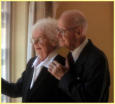ACME History And Basic Principles
 The Association for Couples in Marriage Enrichment is one expression of a movement that began in the 1960s but had its roots earlier. In the 1940s and 1950s those in the helping professions began to view persons not as just individuals but as people living in family systems. Another contributing factor to what is now called "Marriage Enrichment" was the shift from "intervention to prevention." This change emphasized the importance of dealing with personal and interpersonal challenges by providing skills and experiential learning for individuals and families before they got into serious diffivulty. Numerous events were taking place in the early 1960s, resulting in three basic models in the emerging field of marriage enrichment.
The Association for Couples in Marriage Enrichment is one expression of a movement that began in the 1960s but had its roots earlier. In the 1940s and 1950s those in the helping professions began to view persons not as just individuals but as people living in family systems. Another contributing factor to what is now called "Marriage Enrichment" was the shift from "intervention to prevention." This change emphasized the importance of dealing with personal and interpersonal challenges by providing skills and experiential learning for individuals and families before they got into serious diffivulty. Numerous events were taking place in the early 1960s, resulting in three basic models in the emerging field of marriage enrichment.
In 1962, David and Vera Mace conducted their first Marriage Enrichment retreat in Kirkridge, Pennsylvania.  They were searching for ways to prevent marital difficulties by working with couples who were not in crisis but wanted to learn skills for living in harmony. Certain components of the Maces' approach seemed to enhance the learning experience of the participants. These components included a husband/wife leadership team, limited structure, agenda building by the participants, group sharing, and couple dialogue. The Leader couple were full participants in this process.
They were searching for ways to prevent marital difficulties by working with couples who were not in crisis but wanted to learn skills for living in harmony. Certain components of the Maces' approach seemed to enhance the learning experience of the participants. These components included a husband/wife leadership team, limited structure, agenda building by the participants, group sharing, and couple dialogue. The Leader couple were full participants in this process.
 In 1962, unaware of the work of David and Vera Mace in the USA, Father Gabriel Calvo began meeting with couples in Barcelona, Spain for the purpose of strengthening marriages and families. Father Calvo devised the term "marriage encounter" for his program. With its roots in the Roman Catholic Church, marriage encounter was transplanted to the USA in 1967 by the Christian Family Movement. In its present form, Marriage Encounter has emerged with a highly structured format using no group interaction. Couple leaders present a series of lectures, to which participating couples respond in private. Privately, couples write and share letters with each other. A priest is in attendance for counsel and guidance.
In 1962, unaware of the work of David and Vera Mace in the USA, Father Gabriel Calvo began meeting with couples in Barcelona, Spain for the purpose of strengthening marriages and families. Father Calvo devised the term "marriage encounter" for his program. With its roots in the Roman Catholic Church, marriage encounter was transplanted to the USA in 1967 by the Christian Family Movement. In its present form, Marriage Encounter has emerged with a highly structured format using no group interaction. Couple leaders present a series of lectures, to which participating couples respond in private. Privately, couples write and share letters with each other. A priest is in attendance for counsel and guidance.
In 1962, Leon Smith was appointed by the United Marriage Church in the USA to develop a ministry in marriage: preparation for marriage, marraige education, and marriage counseling. In 1964, Leon and his wife, Antoinette, presented the Marriage Communication Labs (MCL), a four-day structured program which included experiential and educational components. Communication skills and couple dialogue were emphasized.
The Maces, the Smiths, and Father Calvo are acknowledged pioneers in the field of marriage enrichment. Since 1962, various religious and private groups have combined and adapted different aspects of these three basic models.
In 1973, David and Vera founded the Association for Couples in Marriage Enrichment with the slogan, "To work for better marriages, beginning with our own." According to David Mace:
"Our hope was that it might be quite natural (with no direct religious, political or professional connections of any kind) and might, therefore, become a coordinating agency for other organizations that were developing programs in this new field; that it might undertake the task of setting standards for leadership; that it might encourage the development of local chapters which could promote in their communities the cause of better marriage" (Mace, Close Companions, 1982).The Maces have underlined the importance of what they call a "primary coping system," a tool-kit for couples to use as they carry out the adventure of "growing a marriage." These essentials are:
A Commitment to Growth
. . . the companionship marriage depends for its effectiveness on the growth process, in order to bring about changes that are essential if the couples are to adapt flexibly to each other in a  shared life . . . Only by working patiently and persistently on the task of smoothing out the rough areas of their relationship can they reach the level of interaction that they desire . . .
shared life . . . Only by working patiently and persistently on the task of smoothing out the rough areas of their relationship can they reach the level of interaction that they desire . . .
Unless the couples have made a clear commitment to each other that they intend to work for ongoing growth in their relationship, the strong likelihood is that they will do nothing about it, or that they will make a few half-hearted efforts and then give up (Mace, Close Companions, 1982)
An Effectively Functioning Communication System
Couples must have a mutually agreed upon system of talking with and listening to each other. Since all communication is learned, what is not helpful can be unlearned and new skills substituted for those that hinder the relationship.
The Ability To Make Creative Use of Conflict
 Using conflict creatively to gain more intimacy rather than allowing conflict to tear down the relationship is the third essential for a growing marriage. In order to do this, couples need to understand the normal dynamics of anger, when it is apt to occur in their relationship, and how they can use an anger situation to learn more about themselves and their partner.
Using conflict creatively to gain more intimacy rather than allowing conflict to tear down the relationship is the third essential for a growing marriage. In order to do this, couples need to understand the normal dynamics of anger, when it is apt to occur in their relationship, and how they can use an anger situation to learn more about themselves and their partner.
When marriage enrichment began as an international movement, it originally referred to a weekend retreat. Some couples may still have this limited view, but ACME has long ago proclaimed that marriage enrichment is a process - a lifetime process. It usually begins with a couple’s need or desire for getting more out of their relationship than they currently are getting. Or, in the case of newlyweds, they want to prepare themselves beforehand for the challenges that their marriage will bring.
In each marriage enrichment event, there are several essential parts to the process. These include:
Couple leadership so that a marriage is modeled while skills are being taught; Participation by the leader couple in the growth-inducing segments; The use of group process to encourage individual and couple learning; The achievement of the following specific goals:
- to have a clear picture of where they are now in their relationship;
- to envision the direction in which they want their relationship to grow;
- to gain some tools for moving toward their goals.
These types of learning occur during a marriage enrichment experience:
- affective learning
- becoming more aware of one's feelings, attitudes, and beliefs
- cognitive of intellectual possibilities, new insights
- bahvioral or experiential learning
- learning by doing, by practicing new ways interacting


